How to Choose Honeycomb Ceramic Regenerator?
In recent years, honeycomb regenerative furnaces have developed very rapidly. Since the regenerator can be miniaturized and integrated with the burner, and each burner maintains its independence, it becomes a regenerative burner. It truly achieves extreme waste heat recovery and ultra-low NOX emissions. The energy-saving effect brought by regenerative combustion technology is very obvious. It can absorb the heat of high-temperature flue gas to the maximum extent and avoid heat waste. Honeycomb ceramic regenerator is the key and core component of regenerative high-temperature combustion technology.
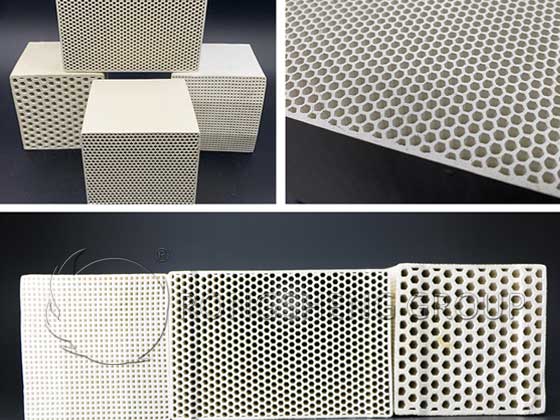
How to Choose the Honeycomb Ceramic Regenerator?
The selection of a honeycomb ceramic regenerator is very critical. Improper selection will cause blockage, burning, collapse, and other phenomena during use, causing the furnace temperature to rise slowly, failing to reach the temperature, and in serious cases causing furnace shutdown accidents. It affects production and increases gas consumption.
Therefore, when selecting a honeycomb body, in addition to considering the rapid cooling and rapid heating resistance of the honeycomb ceramic regenerator, load softening temperature, compressive strength, thermal expansion coefficient thermal shock resistance, and other indicators. The heat release characteristics of the honeycomb ceramic regenerator also need to be considered. It is necessary to select a honeycomb ceramic regenerator made of materials with a large specific surface area, large blackness, large heat capacity, and fast thermal conductivity. In this way, the honeycomb ceramic heat storage body absorbs and releases heat faster and more, and can effectively absorb the heat of the flue gas. Significantly increase the preheating temperature of gas and air, increase the combustion temperature of the heating furnace, and achieve the purpose of reducing gas consumption.
Silicon Carbide Honeycomb Ceramic Regenerator
The silicon carbide honeycomb ceramic regenerator is an improvement based on the formula of the corundum-mullite honeycomb ceramic regenerator. A certain amount of high-purity silicon carbide is added to improve the performance of the original honeycomb ceramic regenerator. Silicon carbide honeycomb ceramic regenerator combines the advantages of silicon carbide, zirconium chromium corundum, and other materials. It has the characteristics of good antioxidant, slag resistance, high-temperature resistance, high blackness, and fast thermal conductivity. Its high-temperature strength can be maintained up to 1600°C, making it the material with the best high-temperature strength among ceramic materials. Due to its fast thermal conductivity and high blackness, it has better energy-saving properties than a corundum-mullite honeycomb ceramic regenerator. According to relevant customer usage statistics, the use of silicon carbide honeycomb ceramic regenerators can significantly reduce the exhaust temperature of exhaust gas and reduce gas energy consumption by more than 5-10% compared with other honeycomb ceramic regenerators. Silicon carbide honeycomb ceramic regenerator is mainly used as the heat exchange medium for high-temperature regenerative industrial kilns above 1250°C.
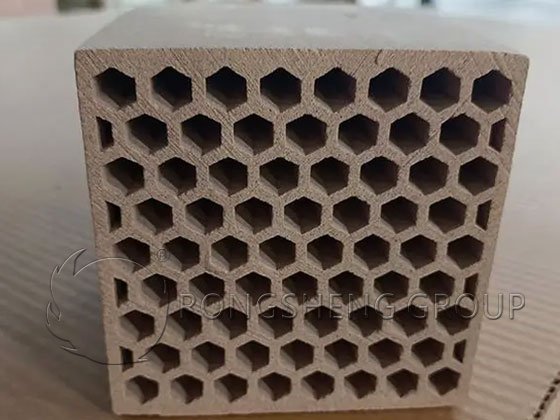
Large Holes and Big Eyes Honeycomb Ceramic Regenerator
The hole shapes of honeycomb ceramic regenerators often include square holes, round holes, hexagonal holes, etc., and the hole spacing is usually between 3-6mm. Among them, the hexagonal hole surface layout is more uniform and the structure is more stable. It is currently the most commonly used hole type. In addition to matching the medium pressure, flow rate, burner combustion capacity, and other factors, the selection of hole type and aperture should also pay attention to the actual medium quality conditions. For exhaust gas with high dust content, the hole diameter and wall thickness should be appropriately increased. Choose a honeycomb ceramic regenerator with large holes and large eyes to reduce the clogging and corrosion hazards caused to the honeycomb ceramic regenerator.
The honeycomb ceramic regenerator with large holes and large eyes is mainly used to deal with the harsh working environment of some industrial furnaces and the high dust content in the flue gas. During use, the small holes of the honeycomb ceramic regenerator often become blocked. After the small holes of the honeycomb ceramic regenerator are blocked, not only will its heat storage and smoke exhaust performance be significantly reduced. It also causes smoke exhaust and uneven heating of the honeycomb ceramic heat storage body, which is prone to cracks and aggravates its damage. In regenerative industrial furnaces with harsh working environments and high dust content in flue gas, the use of honeycomb ceramic regenerators with large holes and large eyes can effectively avoid clogging the small holes of conventional honeycomb ceramic regenerators.
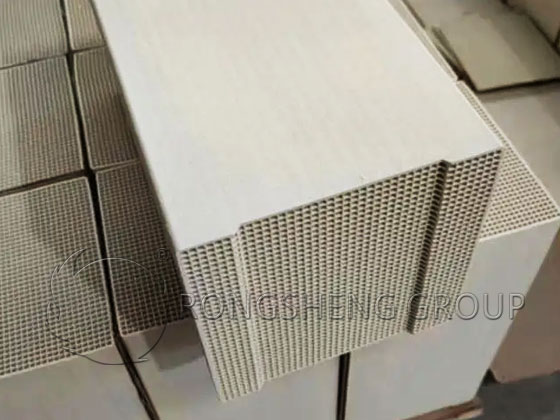
RTO Incinerator Honeycomb Ceramic Regenerator
The honeycomb ceramic regenerator of the RTO incinerator has the characteristics of high softening temperature under load, small expansion coefficient, strong resistance to rapid cooling and rapid heating, and long service life. The basic principle of an RTO incinerator is to oxidize organic waste gas at high temperatures (>760℃) to generate CO2 and H2O. The use of honeycomb ceramic regenerators can maximize the recovery and reuse of heat energy, with a heat recovery rate greater than 95%. The geometric characteristics of the RTO honeycomb ceramic regenerator are generally made into columnar regenerators with dimensions of 150mm×150mm×150mm and 150mm×150mm×300mm and are integrated into the RTO regenerator. The number of holes in the cross-section of a piece of packing that airflow passes through is called the hole density, also expressed by the number of holes per square inch (CSI). Usually from 13×13 (number of holes 169) to 60×60 (number of holes 3600).
The greater the hole density, the larger the surface area per unit volume, which can provide a larger heat transfer area and thereby improve the heat transfer efficiency. The organic waste gas is heated to above 760°C, causing the VOC in the waste gas to oxidize and decompose into carbon dioxide and water. The high-temperature gas generated by oxidation flows through the special ceramic heat storage body, causing the ceramic body to heat up and “storage heat”. This “heat storage” is used to preheat the subsequent incoming organic waste gas. This saves fuel consumption for exhaust gas heating.
The honeycomb ceramic regenerator of the RTO incinerator should be divided into two or more zones or chambers. Each regenerator goes through the procedures of “heat storage-heat release-cleaning” in turn, starting over and over again and working continuously. After the regenerator “releases heat”, part of the clean exhaust gas that has been processed should be introduced immediately, and the regenerator should be cleaned to ensure that the VOC removal rate is above 95%. Only after cleaning is completed can the “heat storage” program be entered.
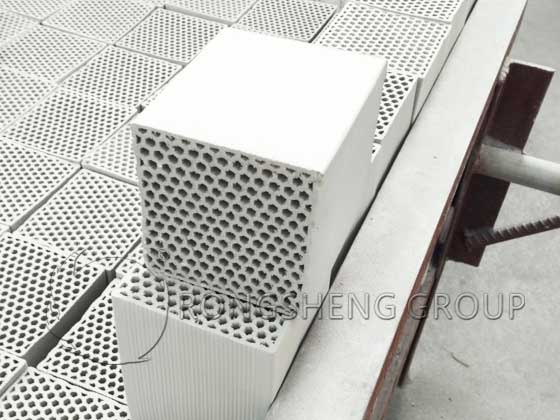
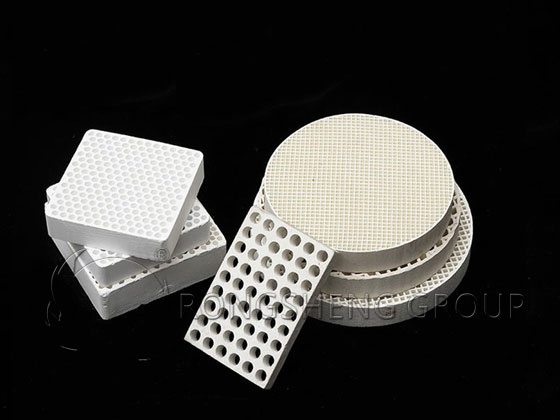
Honeycomb ceramic regenerator is the key material of regenerative industrial kilns, and it is the heat exchange medium of regenerative industrial kilns. The honeycomb ceramic regenerator absorbs and stores the heat from the waste gas in the industrial kiln, and then uses the stored heat to heat the air and fuel. This not only increases the calorific value of the fuel, lowers the emission temperature of exhaust gas, and saves energy, but also reduces the emissions of CO2 and NOX, which is helpful for environmental protection. The cross-sectional holes of honeycomb ceramic regenerators mainly have square, regular hexagonal, and circular three-hole structures. Moreover, the pores are straight channel structures that are parallel to each other. This structure greatly reduces the resistance of the pores to flow through and greatly improves the single-hole volume heat transfer efficiency of the honeycomb ceramic regenerator. The main materials of the honeycomb ceramic regenerator of the RTO incinerator are dense cordierite, high alumina, corundum mullite, chromium corundum, zirconium corundum, silicon carbide, etc. Contact us for a free quote.